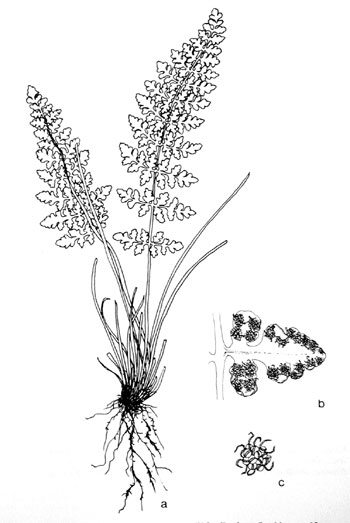|
Hardy Fern Home W. oregana resources All Ferns � Woodsiaceae �� Woodsia
�Other Genera
|
| Woodsia oregana | ||
Western cliff fern, Oregon cliff fern | ||
|
Etymology
Oregana is the Latinization of the U.S. state of Oregon.
Description
Rhizome: erect, scales brown, uniform and others with a dark central stripe.
Frond: 25 cm high by 5 cm wide, deciduous, monomorphic, blade/stipe ratio: . Stipe: persistent bases of unequal lengths, dark reddish-brown at and above the base, glabrous or a few scales, vascular bundles: 2, round or oblong. Blade: 2-pinnate or somewhat more at the base, linear-lanceolate, herbaceous, dull green, glands on both surfaces, rachis, costa with glandular hairs and scattered, often hairlike scales. Pinnae: 10 to 14 pair, triangular-oblong, pairs further apart the closer to the base, opposite; costae grooved above, grooves continuous from rachis to costae; margins crenate to serrate, often rolled under; veins free, simple or forked, ending before the margin. Sori: round, in 1 row between midrib and margin, indusium: narrow, thread-like or hair-like segments, small, basal, surrounding, sporangia: brown, maturity: midsummer. Dimensionality: pinnae held close to the horizontal. Culture
Habitat: crevices, rock bases, talus slopes on calcareous substrates.
Distribution: western North America, but extending east to Quebec, Vermont.
Hardy to -30�C, USDA Zone 4.
Distinctive Characteristics
Distinguished from several Woodsia by the irregular lengths of old stipe bases, from W. scopulina by the nearly glabrous blade surface and the stipe brown only near the base vs. shiny chestnut-brown stipe and rachis in W. scopulina. From W. obtusa by the indusium thread-like here vs. four lobes, and the margins often inrolled here.
Synonyms
Woodsia cathcartiana B. L. Robinson |
|
|
Notes
Subtaxa A subspiecies or variety (or even species) cathcartiana is differentiated by characters undetectable by the naked eye.
Subtaxa A subspiecies or variety (or even species) cathcartiana is differentiated by characters undetectable by the naked eye.
